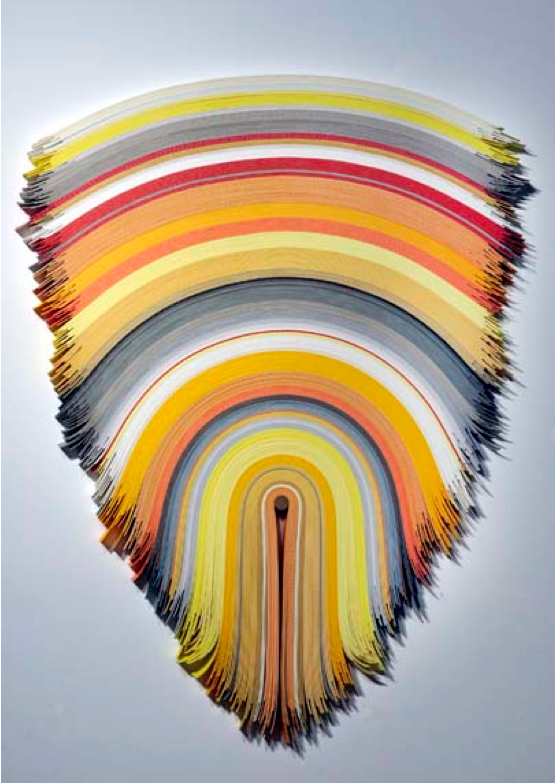Raw to Refined: string, tape, sponges and vinyl
January 14, 2014
“Raw to Refined: String, Tape, Sponges and Vinyl,” a new exhibition of artwork created with unconventional materials, has opened at Drexel University’s Leonard Pearlstein Gallery (3401 Filbert St.) and will run through Friday, March 21, 2014.
The exhibition, which is hosted by Drexel University’s Antoinette Westphal College of Media Arts & Design in collaboration with Philadelphia’s Pentimenti Gallery, features abstract wall pieces constructed of wood and vinyl, a mural of translucent packing tape, textured wall hangings created from sponges, an installation of laced red twine and other works from artists Margery Amdur, Mark Khaisman, Derrick Velasquez and Nami Yamamoto.
Raw to Refined on flickr
Raw to Refined” will include a series of free and open-to-the-public workshops.

Every Wednesday through March 21, artist Margery Amdur will host a workshop from 11:30 a.m. to 2:30 p.m. in the Pearlstein Gallery, during which participants will help her build a new installation made of cosmetic sponges. Amdur is a process-based artist whose materials and fabrication process is as much a part of the work as the finished pieces. Her pieces are often built in collaboration with friends and students, further emphasizing the communal process mostly identified in craft works. Her work has been featured in more than 50 exhibitions all over the world.
On Feb. 19, Design Futures Lab Director and Architecture & Interiors Professor Nicole Koltick will host a workshop with artist Mark Khaisman, leading participants in the creation of a drawing made out of packing tape and Plexiglass. Khaisman’s works are pictorial illusions formed by light and shadow. His medium consists of three elements: translucent packing tape, clear acrylic panels and a light source. By layering and bunching opaque tape, he uses light to create works highlighted by color, shading and texture. Born in Kiev, Khaisman studied art and architecture at the Moscow Architectural Institute in Moscow. He has been the recipient of many awards, and his works are found in the collections of Brandywine Trust Collection, Philadelphia; British Airline Collection, London; Delaware Art Museum, Wilmington, Del.; NBC Collection, New York; Vitra Design Museum, Weil am Rhein, Germany; and West Collection, Philadelphia.
On March 5, artist Nami Yamamoto will conduct a workshop to teach guests how to create their own filet lace from 6 p.m. to 9 p.m. in the Pearlstein Gallery. Yamamoto says that her artistic process is governed by an empirical investigation of her surroundings, which, when translated into an aesthetic experience, helps her to better understand this world. Merging science and poetry, her work begins with a survey of the environment, collecting interesting material of natural and manmade ephemera or noticing some natural phenomenon.
Margery Amdur is a process-based artist whose materials and fabrication process are as much a part of the work as the finished pieces. Most recently she has focused on creating sculpture with cosmetic sponges. Often these pieces are built in collaboration with friends and students, further emphasizing the communal process mostly identified in craft works. Amdur received her Bachelor of Fine Arts degree from Carnegie-Mellon University and her Master of Fine Arts from the University of Wisconsin in Madison. Amdur’s work has been featured in more than 50 exhibitions, including those in Turkey, Hungary and England. She has curated and organized two national exhibitions. Amdur is the recipient of more than a dozen awards and grants. She has been reviewed in national and international publications, including Sculpture Magazine, New American Paintings, Seams to be Constructed and New Art Examiner.
Mark Khaisman’s works are pictorial illusions formed by light and shadow. His medium consists of three elements: translucent packing tape, clear acrylic panels and light. By layering and bunching opaque tape, he uses light to break through and create transparencies highlighted by color, shading and texture. Born in Kiev, Khaisman studied art and architecture at the Moscow Architectural Institute in Moscow. He has been the recipient of many awards, and his works are found in the collections of Brandywine Trust Collection, Philadelphia; British Airline Collection, London; Delaware Art Museum, Wilmington, Del.; NBC Collection, New York; Vitra Design Museum, Weil am Rhein, Germany; and West Collection, Philadelphia.
Derrick Velasquez’s work investigates process by channeling the forces of gravity and tension between materials like plywood, two-by-fours, Masonite, marine vinyl, acrylic, hardwoods and the human body. He constructs a language of structure that plays with traditional concepts of physical and psychological interactions with industrially manufactured materials. Velasquez received his bachelor’s degree from the University of California, Santa Barbara, and his Master of Fine Arts degree from The Ohio State University. Velasquez’s work is in the collection of the Metropolitan State University of Denver and in private collections in Denver, Philadelphia, New York, Miami and more. He is represented by Pentimenti.
Nami Yamamoto’s artistic process is governed chiefly by an empirical investigation of her surroundings, which, when translated into an aesthetic experience, helps her to better understand this world. Merging science and poetry, her work begins with a survey of the environment, collecting interesting material of natural and manmade ephemera or noticing some natural phenomenon. Yamamoto received her Master of Fine Arts degree from Maryland Institute, College of Art in 2001. She received her bachelor of fine arts degree from Aichi Prefectural University of Fine Arts in Japan.